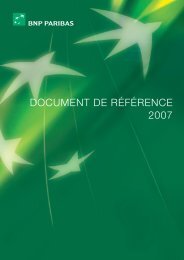2007 REGISTRATION DOCUMENT
2007 REGISTRATION DOCUMENT
2007 REGISTRATION DOCUMENT
- No tags were found...
You also want an ePaper? Increase the reach of your titles
YUMPU automatically turns print PDFs into web optimized ePapers that Google loves.
RISK MANAGEMENTRisk factors 3UNFORESEEN EVENTS CAN INTERRUPT THEBANK’S OPERATIONS AND CAUSE SUBSTANTIALLOSSES AND ADDITIONAL COSTSUnforeseen events such as severe natural disasters, terrorist attacks orother states of emergency could lead to an abrupt interruption of theBank’s operations and, to the extent not covered by insurance, couldcause substantial losses. Such losses can relate to property, financialassets, trading positions and key staff. Such events could also lead toadditional costs (such as relocation of employees affected) and increasethe Bank’s costs (particularly insurance premiums). These types of eventmay also make it impossible for the Bank to obtain insurance coverageand thus increase its overall risk.THE BANK IS SUBJECT TO A STRICTREGULATORY FRAMEWORK IN THE COUNTRIESAND REGIONS IN WHICH IT OPERATESRegulatory compliance risk arises from a failure or inability to complyfully with the laws, regulations or codes applicable specifically to thefinancial services industry. Non-compliance could lead to fines, publicreprimand, damage to reputation, enforced suspension of operations or,in extreme cases, withdrawal of operating licences.The Group’s businesses and earnings can be affected by the fiscalmeasures and other policies adopted by regulatory authorities inFrance and other European Union countries, foreign governments orinternational agencies. The nature and impact of future changes in suchpolicies and regulatory measures are unpredictable and are beyond theGroup’s control.ANY CHANGE IN THE FOLLOWING AREASIS LIKELY TO IMPACT THE GROUP■ the monetary, interest rate and other policies of central banks andregulatory authorities;■ general changes in government or regulatory policy that may influenceinvestor decisions, particularly in the markets in which the Groupoperates;■ general changes in regulatory requirements, for example, prudentialrules relating to the capital adequacy framework;■ changes in the competitive landscape and pricing strategies;■ expropriation, nationalisation, confiscation of assets and changes inlegislation relating to foreign ownership;■ any unfavourable changes in the political, military or diplomaticsituation leading to social unrest or legal uncertainly, potentiallyaffecting demand for the Group’s products and services.< Contents >THE BANK’S RISK MANAGEMENT POLICIES,PROCEDURES AND METHODS MAYLEAVE IT EXPOSED TO UNIDENTIFIED ORUNANTICIPATED RISKS, WHICH COULD LEADTO MATERIAL LOSSESThe Bank has devoted considerable resources to developing its riskmanagement policies, procedures and assessment methods and intendsto further develop them in the future. Nonetheless, the Bank’s riskmanagement techniques and strategies may not be fully effective inmitigating its risk exposure in all economic market environments oragainst all types of risk, particularly risks that the Bank would havefail to identify or anticipate. Some of the Bank’s qualitative tools andmetrics for managing risk are based on the use of observed historicalmarket behaviour. The Bank applies statistical and other tools to theseobservations to derive the quantification of its risk exposures. These toolsand metrics may deliver inadequate results on future risk exposures, e.g.if the Bank may not anticipate or correctly evaluate certain factors inits statistical models. This could limit the Bank’s ability to mitigate itsrisks. The Bank’s losses could therefore be significantly greater than thehistorical measures indicate. In addition, the Bank’s quantitative modelsdoes not take all risks into account. Its more qualitative approach tomanaging certain risks could prove insufficient, exposing it to materialunexpected losses.THE BANK’S HEDGING STRATEGIES MAY NOTPREVENT LOSSESIf any of the variety of instruments and strategies that the Bank usesto hedge its exposure to various types of risk in its businesses is noteffective, the Bank may incur losses. Many of its strategies are basedon historical trading patterns and correlations. For example, if the Bankholds a long position in an asset, it may hedge that position by taking ashort position in another asset where the short position has historicallymoved in a direction that would offset a change in the value of the longposition. However, the hedge may only be partial, or the strategies usedmay not protect against all future risks or may not be fully effectivein mitigating the Bank’s risk exposure in all market environments oragainst all types of risk in the future. Unexpected market developmentsmay also reduce the effectiveness of the Bank’s hedging strategies. Inaddition, the manner in which gains and losses resulting from certainineffective hedges are recorded may result in additional volatility in theBank’s reported earnings.1234567891011<strong>2007</strong> Registration document - BNP PARIBAS 73
















